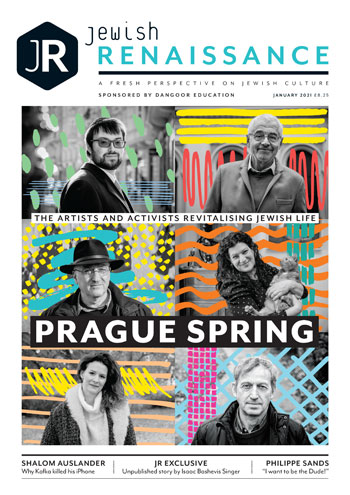
In 2001, Janet Levin told her local book club she was going to start a magazine. She wanted their help to shape it. Her idea was niche, but she knew there would be readers – she worked in market research. Jewish Renaissance would cover culture with a Jewish slant. Readers wouldn’t necessarily be religious; they would just feel drawn to their heritage. “I was told it wouldn’t last two issues, let alone two years,” Levin has said. Yet, on she wrestled with QuarkXPress from her house in Richmond – and her efforts paid off. In 2007 and 2009, JR was shortlisted for the PPA Independent Publishers Achievement Award. This year, it turns 20.
The inside track
The quarterly magazine, comprising arts reviews, listings and features, has run pieces by a host of big hitters including poet Michael Rosen, film director Mike Leigh and author Lynne Reid Banks. “You don’t want to be hostage to celebrity names,” says Rebecca Taylor, who joined as editor in 2015, “but commissioning established writers is important to us. All of us pull on our contacts for the magazine.”

Contacts have been vital from the start. Levin had once done some market research for the Jewish Chronicle, a long-established community paper, and asked Lionel Gordon, its former chairman, to join JR in the same role. Together, Levin and Gordon garnered an advisory board, including the heads of the Jewish Music Institute and Camden’s Jewish Museum, and ‘names’ Maureen Lipman and Arnold Wesker. The board helped distribute 70,000 flyers.
To get going, the magazine relied heavily on philanthropy. Naim Dangoor, head of the Iraqi community, contributed £2,000 in exchange for a piece about the Jews of Iraq. (Dangoor Education, a charitable foundation run by Dangoor’s son David, is JR’s largest donor today.) But the magazine couldn’t depend on generosity; it needed readers. By the second issue, out in early 2002, subscriptions numbered 1,000. “Janet was running it pretty much single-handedly,” says Taylor. “She knew all the readers by name and was really savvy at marketing it.”
The magazine is not about being Jewish. It’s looking at Jewish influences. I don’t want it to feel exclusive.
We’re all kosher now
JR now has a readership of about 12,000, taking into account the relatives of subscribers who flip through it at the kitchen table and copies sent to synagogues and care homes. Batches are also sold at the Jewish Museum and at events like Klezmer in the Park, an annual music festival in London.
Print subscribers, says Dr Aviva Dautch, JR’s executive director and a university lecturer, number just over 4,000, with a further clutch of readers accessing it through the app. Subscriptions have increased by 10 percent in the past six months, a response Dautch attributes to JR’s online events, curated as ‘JR Home Entertainment’. Readers have also said they’ve recently valued the magazine more than ever: it’s helped them feel connected during an anxious time.
Most subscribers are, unsurprisingly, Jewish, although ‘ish’ is very much part of it. “The magazine is not about being Jewish,” says Taylor, who grew up on the Kent / London border where there were few Jews around. “It’s looking at Jewish influences. I don’t want it to feel exclusive. The Jewish community is small – Jews make up 0.4 percent of the UK population – so I feel we should be embracing everyone, regardless of their background or practices.”
Drilling into the numbers, most readers live in London (60 percent of Jews in the UK are based in the capital), followed by Manchester and Leeds. Subscribers are also drawn from Edinburgh, Glasgow, Belfast, Dublin, Italy, Belgium, North America, Israel, Australia, India and Japan. “We see ourselves as part of a global community,” says Taylor, who spent a decade in Tokyo teaching English after she graduated. “Rather than covering local Jewish news, we see what connects us to communities in other places. It’s really important that we’re outward-looking and open.” Howard Jacobson, the Booker Prize-winner and a JR reader, has made a similar point, arguing that the magazine “rescues English Jews from the curse of the parochial, reuniting us with the wider, grander, older and newer world of Jewish thought and events”. He has called it “essential reading” for all.
The Jews of Iraq feature in the launch issue has led to a ‘Passport’ series, focusing on Jewish communities around the world: from the unexpected (the Caribbean) to the local (‘philo-Semite’ Julie Burchill wrote a piece for the one on Brighton). JR tries particularly hard to cover Sephardi Jews – those who trace their heritage back to the Mediterranean, Middle East and North Africa, as opposed to Ashkenazi Jews from Eastern Europe – by running a regular pull-out focused on them. Only 2 percent of UK Jews identify as Sephardi. “We want to cover Jewish communities who might have been marginalised in British history,” says Taylor.
The magazine rescues English Jews from the curse of the parochial, reuniting us with the wider, grander, older and newer world of Jewish thought and events.
Howard Jacobson
Defining the brand
The team of five often debate what unites Jewish communities (the nearest they’ve got is the idea that people feel they belong to the same tradition) and how they should define Jewish culture. “Every issue I’m faced with this challenge of thinking, ‘What an earth is it?”, says Taylor. “I try not to include things just because a Jewish person is involved, but I also want to showcase the contributions of Jewish people to society.” Taylor reels off examples from Abram Games, who designed some of Britain’s most distinctive Second World War posters to Ottolenghi, who has converted us all to the wonder of pomegranates.
“Readers sometimes say, ‘Can we have more science or more business or more sport?’ But it’s difficult to make an argument for them because there is nothing about them that is specifically Jewish.” The arts and food, however, may have Jewish traces. “Sometimes we have to pick up nuances from certain traditions. It’s a challenge every issue to decide how we’re going to approach it.”
The one thing the team does agree on is what doesn’t unite or define Jews. “Jews are not united because of antisemitism or Israel,” says Taylor, “especially not Israel because people feel so differently about it.”
Not that they can get away from antisemitism entirely. Last year, Taylor interviewed Labour MP Dame Margaret Hodge and Dame Louise Ellman, a former Labour MP who resigned because she was concerned about the party’s attitudes towards Jews. Taylor, who joined JR after ten years as news editor of Time Out, decided to tackle the issue head on. “I want the magazine to feel timely and connected to political and social life,” she says. When JR includes pieces about the Holocaust, they find novel approaches. “It’s a really important part of our history,” admits Taylor, “but there is more to being Jewish.” Readers don’t necessarily want to read about it either. One recent letter said, “Can we have one issue that doesn’t have anything to do with the past?”
Most subscribers are over 60 (including 7 percent over 80) and, like many publications, JR would like more younger ones – perhaps, in their 40s and 50s. “Wherever I’ve worked, there’s been the mantra, ‘We must attract younger readers,” says Taylor. “We need to at JR because, at some point, our readers won’t be around, but we appeal to a certain demographic just because of what we do and our subscribers are really loyal.” About 20 percent are under 40, with the younger demographic, attracted by digital offerings, gaining ground.
As part of its efforts to appeal to a wider readership, JR launched the Young Journalist Prize last year, which was open to 16-25-year olds. The competition, which was judged by a panel including film critic Jason Solomons and Guardian columnist Jonathan Freedland, attracted dozens of entries on topics from Jewish gangsters to the need for Muslim-Jewish solidarity.
Their biggest hope for attracting younger readers, however, is through digital. The website and social media accounts, run by associate editor Danielle Goldstein, who worked with Taylor at Time Out, are a recent priority. The numbers are still small, but provide a base. Last year, the website attracted an average 4.5k unique page views a month. JR Twitter followers currently number 3.5k, Instagram is at 3.4k, while Facebook likes are at 1k.
Smaller magazines can do well because they know their readers and speak so brilliantly to them.
Life post-pandemic
Taylor is confident that some of the website browsers and guests to online events will become subscribers. She has been buoyed by the success of the JR Book Club, which launched in September, and virtual issue launches, where the magazine has hooked up with venues around the world (one last year was run with the Washington Jewish Museum to tie in with the US Election). “We’d been talking about doing those sorts of things for ages and then they happened because they had to,” says Taylor. Online events, which are frequently attended by more than 100 people, are making money. “It’s another arm for us and it enables us to connect with people… It has given us a push to do what we should have been doing anyway.” The team plans to carry on with them.
Eventually, the team hopes to revive other arms of the brand. JR Tours, a spin-off with West End Travel, taking groups to countries like China, Ethiopia and Morocco to learn about local Jewish communities, had been popular before the pandemic. JR also aims to establish relationships with organisations, such as the Council of Christians and Jews, and strengthen existing ones with the Jewish Film Festival and Jewish Book Week, where they hold events. They help brand awareness.
To celebrate its birthday, JR will be publishing a book looking back at Jewish culture over the past 20 years and holding a party. “Smaller magazines can do well because they know their readers and speak so brilliantly to them,” says Taylor. “We’ve thrived recently because people have been desperate for a sense of belonging. We’d been trying to create a community for years. I finally feel like we’ve done it.”
This article was first published in InPublishing magazine. If you would like to be added to the free mailing list, please register here.










